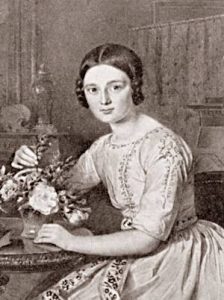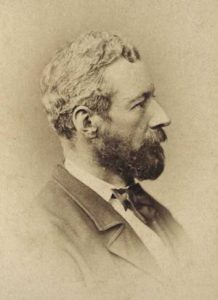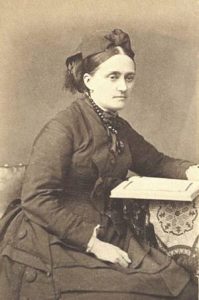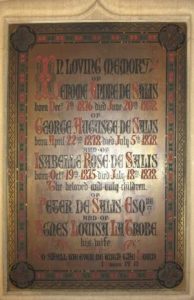
Aged two and a half, Agnes La Trobe arrived in Melbourne with her parents, Charles Joseph and Sophie La Trobe, on 3 October 1839 and lived in the family’s prefabricated cottage Jolimont erected on a 12½ acre (5 ha) site – part of the police paddock – that the newly appointed Superintendent was required to purchase himself. By the time she was nearly five she had a younger sister, Eleanora, and the following year a second sister, Cécile. She was known for her youthful high spirits, possessing a temperament that family friend Georgiana McCrae described as ‘very volatile and quick’. In a letter to one of his relatives soon after her fifth birthday her father wrote that: ‘Agnes is a noble little girl… & full of talent, but as wild as a march hare & giddy beyond endurance’; he hoped ‘for her sake as well as her mother’s’, that they would all be able to return to Europe ‘in a year or two ’. At Jolimont her father was keen to pass on to her his love of plants. Meanwhile, her conduct began to deeply trouble her parents who felt that she was being allowed to run wild at Jolimont, and eventually it was decided that Agnes, aged just eight, should be sent to the care of her mother’s family in Neuchâtel, Switzerland, to be properly educated.
Agnes travelled to England on the barque Rajah under the care of the captain’s wife, Kezia Ferguson, who gave her daily lessons during the five and a half month voyage commencing 24 April 1845. Mrs Ferguson wrote in her journal:
Friday April 25. … I am quite sure she is heartsick and now realizes that she is parted from you. She is constantly saying with tearful eyes ‘I want Mamman. I wish I were with Mamman’.
Saturday April 26. Agnes has not left her bed today having been thoroughly sea sick but she has been sweetly patient…though she has called out very many times ‘I want my Mamman & Papa’.
Monday April 28. Yesterday Agnes was rather better though still sea sick…she is quite cheerful but frequently says: ‘I want to see my Mamman,’ ‘I shall never be quite happy until I see my Mamman’.
Friday May 30. We have again had bad weather and been compelled to [heave-to]. Today has been more moderate and Agnes has been able to do her lessons but now tonight while I write we are threatened with another gale. It is very trying weather and we all feel it very much except Agnes and she seemed quite invulnerable to storms and tempests. She is lively, happy and talkative as ever and under all circumstances is very good. I become more convinced of the excellence of her disposition.
Saturday Septr 13. Agnes has been tolerably good today and has completed her [embroidery] sampler of which she is not a little proud.
Saturday morning Octr 4. We anchored last night above Margate and are now on our way to Gravesend where I hope we may be in a few hours. I wrote to Mr [Peter] La Trobe and Mr Mollison so Agnes’s arrival is known to them. She is quite well and has been very good and is quite pleased to land with good nails she says. [She had been in the habit of biting her nails.]


Altogether, Agnes lived in Switzerland for nine years before moving to school in England and then joining her reunited family there. Subsequently they moved to Whitbourne in Herefordshire (1858-1866) and later to Litlington, near Eastbourne in Sussex. In October 1874 she married Comte Pierre de Salis-Soglio, was thereafter known as the Comtesse de Salis-Soglio, and lived for the rest of her life in Neuchâtel. She gave birth to five children, only one of whom, Elisabeth Sophie born in 1880, reached adulthood. Her three eldest children all died in 1878 from diphtheria, and there is a memorial to them – ‘the beloved and only children’ – in the Chapelle de l’Ermitage, erected in memory of her father overlooking the glorious lake in Neuchâtel. Her husband, Pierre de Salis-Soglio (1827-1919), painter and engraver, was conservator (the director) of the art museum in Neuchâtel.

Her daughter Elisabeth, the Baronne de Blonay, presented a large consignment of La Trobe correspondence and pictures to State Library Victoria in 1934 to mark the centenary of the foundation of Victoria and Melbourne in 1934/35. Other papers were later deposited in the State Archives of Neuchâtel, and most of these have been copied since for State Library Victoria.
Agnes is honoured by a number of place names in South Gippsland: the Agnes River (named by her father during his journey of exploration in early 1845, before her departure for Switzerland); the Agnes Falls – the highest waterfalls in Victoria; and the settlement of Agnes on the South Gippsland Highway, near Corner Inlet. She is also honoured by Agnes Street in East Melbourne that was so named when La Trobe’s Jolimont estate was subdivided in 1857, following his eventual departure from Victoria in May 1854.
NOTE: Agnes Louisa La Trobe was born in Neuchâtel on 2 April 1837, while her father was in the West Indies on an official posting for the British Colonial Office investigating the educational needs of the recently emancipated slaves. She died in Neuchâtel on 15 May 1916, aged 79.
References:
Chronicle of the life of Agnes La Trobe, MS 14152, Australian Manuscripts Collection, State Library Victoria (in French – copy of the original chronical that is held in Neuchâtel).
Diary of Kezia Ferguson on voyage of “Rajah” from Port Phillip to London, 1845, MS 13354/24, Australian Manuscripts Collection, State Library Victoria (copy of the original diary that is held in Neuchâtel).
Marguerite Hancock, Colonial Consorts: the wives of Victoria’s governors 1839-1900, Carlton South: Miegunyah Press, 2001, Chapter 1.
